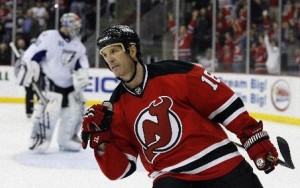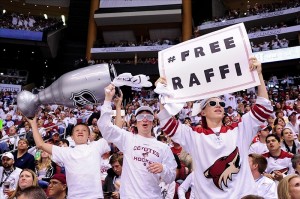
If you’ve ever had to babysit children for a long period of time, you know that at some point you’ll have to be the bad guy and discipline them. Lay down the law and let them know you’re running the show. Throwing their toys at each others faces? That is not going to fly. Obviously that never happened on my watch though…
The NHL has always been streaky with their discipline. After Colin Campbell’s son Gregory Campbell became a constant fixture on the Bruins, Colin stepped down and became the Director of Hockey Operations citing conflict of interest. (There was also that fake artist email thing.) The spot was left open and many agreed “the old boys club” method of ex-NHLers taking the disciplinary position would not create any difference in player safety. After rumours swirled Brendan Shanahan would take Colin’s place, he eventually did and began to make changes.
Shanahan retired in 2009 which created some controversy around the choice. As a former player only two years before taking the position of Senior Vice President of Player Safety and Hockey Operations, Shanahan was still one of the boys. I wonder if that’s engraved on his nameplate at his desk… Anyway, the controversy surrounding the idea that Shanahan would step in as head disciplinarian would mean he would ultimately come into contact with teammates and close friends that he would have to suspend. Was this conflict of interest just like Colin Campbell?
The first suspension Shanahan gave out was earned by Jody Shelley of the Philadelphia Flyers. The video review of the play, the explanation of the rule, and the commentary during the incident helped fans see why he came to his decision, and how. This marked the first time the thought process was revealed. An explanation of the suspension showed exactly why this play was deemed unsafe and warranting suspension. Not only was this helpful to NHL fans, but the players as well. A line was being drawn to show what was acceptable. A new sheriff was in town, and he wasn’t going to take it easy.
10 games for Jody Shelley – 5 pre season and 5 regular season – was the first Shanaban, and the trend continued. Repeat offender, defenseless player – these are terms hockey fans learned to add to their vocabulary.
After this suspension, it was assumed Shanahan would finally be giving out consistent suspensions that we could all agree were warranted. Or so we hoped.
The Raffi Torres saga is a great place to start. Torres absolutely obliterated three NHL rules with one bruising hit to Marian Hossa in April of 2012. As a repeat offender who offends by making dangerous plays, the ruling on this hit would be 25 games. There were only two people on earth upset with this ruling; Torres, and his agent. The suspension was explained clearly by Shanahan. You cannot argue a repeat offender who just broke three rules in 1 second should get anything less.

What happens next? Appealing this decision would be ludicrous, but that is what Raffi Torres did. Gary Bettman went over Brendan Shanahan’s head and reduced that suspension to 21 games. This is a prime example of a mockery to the safety of players around the league. Shanahan explicitly gave a 25 game suspension to Torres and explained perfectly the reasons for it in a video I’m sure Bettman did not view in it’s entirety. How could you argue with Shanahan’s ruling as the VP of Player Safety?
The decision to give Torres 25 games was a message to the rest of the league that these hits would not be tolerated. The message Gary Bettman sent out was “If you feel sad about being reckless, and just want to play hockey, I can help you out. Now don’t do it again, ok?”. Sure Torres doesn’t want to be suspended. Sure, he just wants to play hockey. But when you take another players career into your hands by injuring him severely on an unnecessary play, you don’t deserve to. I think Hossa wanted to be playing hockey too, but he couldn’t. There’s nothing Bettman can do to help Hossa heal faster, so he shouldn’t butt in and help Torres either.
Speaking of circumventing the rules, the NHL had a bit of a situation on their hands with Ryan Clowe. Angered at the check from behind given to teammate Joe Pavelski in front of the San Jose bench by Andrew Shaw. It was a dangerous play as is, but Clowe proceeded to jump onto the ice and pound on Shaw. He illegally left the bench to engage in a fight with Shaw. This is written – in ink, not pencil – that a player who leaves the bench illegally will receive an automatic 10 game suspension. When the ruling came down, Clowe was given 2 games. Shaw received no supplementary discipline, or fine for his hit on Pavelski.
So wait, you’re telling me even though it is written in the rulebook that a player who leaves the bench illegally to engage in a fight will get an automatic 10 game suspension… it isn’t so? How can the rules be bent this far?
The Lockout. Yes, I said it and I’m bringing it up again. The shortened season is proving to be a bit of a burden on the shoulders of Shanny. Suspensions are now being considered in terms of a shortened season. When discipline is handed out based on a timeline, this is where things get more than tricky. The rulebook states a 10 game suspension was coming for Clowe. He deserved it. He was given 2 games. From the angles everyone was given to look at the incident (and there weren’t many) he deserved 10 games.
When suspensions and fines are being looked at in terms of remaining games in the season and salary made in the shortened season, they’re doing it wrong. The intent to injure Marian Hossa was blatant. In this season, Raffi Torres might get 15 games for that hit, which Bettman would reduce to 12. The intent to injure, the complete lack of motive, and the recklessness of the play should not be judged in terms of time. If the hit would get 25 games in a regular season, he deserves 25 in the shortened one. If Clowe deserved 10 in the regular season, he should’ve served a 10 game suspension.
Going soft on suspensions and fines during a shortened season only shows the players there is more wiggle room to play on the edge. It is a sign that the league will be a little more sympathetic to your reckless behaviour which is the opposite of what needs to happen right now.
The last weekend in the NHL was one for the books – and not in a good way. There have been many dangerous plays leading to suspension and fines that have left the NHL world baffled. The last few suspensions have left me sounding like a “What?” compilation video of Don Draper. I’m serious.
Jamie Benn is down $10,000 as he received that petty fine for dangerously cross checking a defenseless Ryan Jones in the back who wasn’t anywhere near the puck. A first-time offender, Benn was fined the maximum amount under the CBA. Since signing a new contract, he could either be fined “$10,000, or one-half of his daily salary.” as the Canadian Press wrote. He was given the lesser fine. $10,000 doesn’t seem like much considering he’ll make $4.5 million this season. A suspension would definitely be awarded in an 82 game season, why should this be any different? Player safety should be number one, not fairness to those who commit these dangerous acts.
This brings us to the most hated rat in the NHL. Patrick Kaleta of the Buffalo Sabres is a repeat offender. He is a great example of how not to play the game. As an effective rat, he goats guys into penalties and runs around trying to take heads off. When he annoys the guys enough and gets himself into a tussle, he turtles. He’s the kind of guy you would never want to have to stick up for, because there really is nothing to stick up for.
His latest offence was a late, dirty, and very Kaleta hit on New York Rangers centre Brad Richards. The proximity to the boards, and the cross check that catapulted Richards neck into those boards was one of the most dangerous plays I’ve seen. With Richards in pursuit of the puck, and Kaleta seeing a golden opportunity to injure, the cross check came and went, and Richards neck seemed to collapse into his diaphragm for a moment. I am surprised, actually it’s a miracle Richards did not break his neck. He returned to the game, and was later diagnosed with a concussion.
Surely, this repeat and reckless offender with no respect for the health or careers of those he chooses to try and decapitate would get a hefty suspension. Not the case. This has to be because of the shortened season, because, really… how could you not lay down the law on Kaleta? A phone hearing was scheduled for earlier today, March 4th, and that meant he would get a maximum of five games. What did he get? 5 games. It’s unfortunate, but the severity of the injury incurred by the injured player is taken into consideration.
If an injured player either breaks his neck, or comes out with a concussion, the discipline should be the same. The intent to injure, and the play made was the same. The injury or lack there of should not be a deciding factor in the supplementary discipline process. Period.

How do the players get the message about what is acceptable and what is not? (Surely something like this illustrates everyones confusion.) The videos Shanahan started compiling are great outlets for unacceptable play, though consistency in suspensions and fines has not been reached. Repeat offender, first time offender, injury, non-injury, intent, whatever the decision making process involves, the play should be looked at for what it is. If you are going to engage in reckless and let’s be honest, stupid plays, it shouldn’t matter who you are, you need to be set straight.
The leniency on dangerous penalties and the reassessment of suspensions in the Raffi Torres case are an embarrassment to the job Brendan Shanahan is trying to do, and the culture change he is trying to make. An offender should be slapped with huge fines and huge suspensions. If you’re facing a 30 game suspension, theres got to be a little voice in your head that says “Maybe I won’t give this guy a concussion.”. Playing with a bit of caution is not going to ruin the league, it might save a few careers.